lock PONTIAC GRAND AM 1998 Owner's Manual
[x] Cancel search | Manufacturer: PONTIAC, Model Year: 1998, Model line: GRAND AM, Model: PONTIAC GRAND AM 1998Pages: 370, PDF Size: 16.11 MB
Page 76 of 370
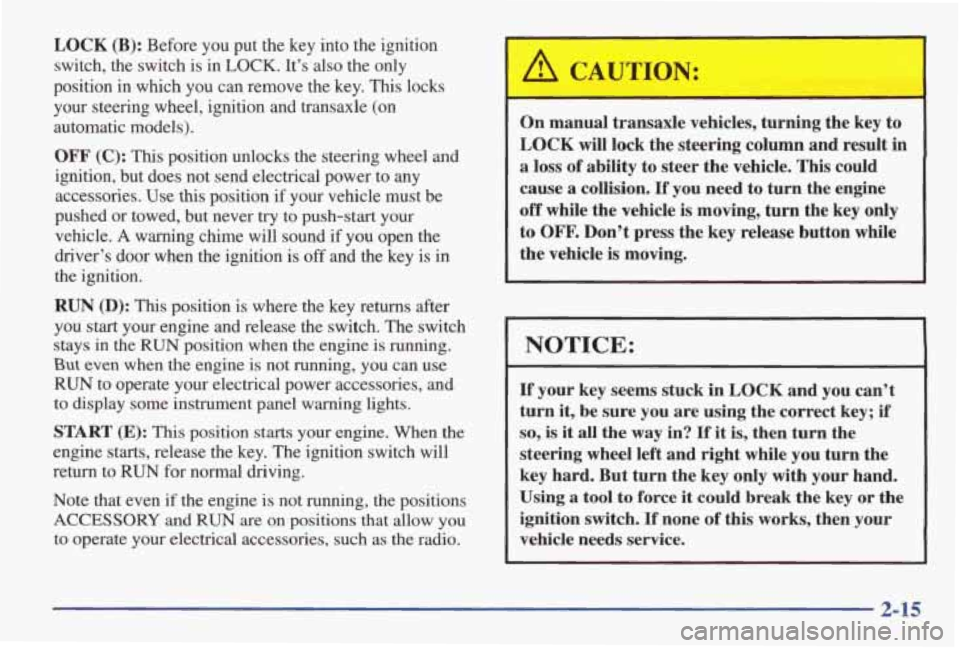
LOCK (B): Before you put the key into the ignition
switch, the switch is in
LOCK. It’s also the only
position in which you can remove the key. This locks
your steering wheel, ignition and transaxle (on automatic models).
OFF (C): This position unlocks the steering wheel and
ignition, but does not send electrical power to any
accessories.
Use this position if your vehicle must be
pushed or towed, but never
try to push-start your
vehicle.
A warning chime will sound if you open the
driver’s door when the ignition is
off and the key is in
the ignition.
RUN @): This position is where the key returns after
you
start your engine and release the switch. The switch
stays
in the RUN position when the engine is running.
But even when the engine is not running, you can use
RUN to operate your electrical power accessories, and
to display some instrument panel warning lights.
START (E): This position starts your engine. When the
engine starts, release the key. The ignition switch
will
return to RUN for normal driving.
Note that even if the engine is not running, the positions
ACCESSORY and RUN are on positions that allow you
to operate your electrical accessories, such as the radio.
On manual transaxle vehicles, turning the key to
LOCK will lock the steering column and result
in
a loss of ability to steer the vehicle. This could
cause a collision.
If you need to turn the engine
off while the vehicle is moving, turn the key only
to OFF. Don’t press the key release button while
the vehicle is moving.
NOTICE:
If your key seems stuck in LOCK and you can’t
turn it, be sure you are using the correct key; if
so, is it all the way in? If it is, then turn the
steering wheel left and right while you turn the
key hard. But turn the key only with your hand.
Using a tool to force it could break the key or the
ignition switch.
If none of this works, then your
vehicle needs service.
2-15
Page 77 of 370
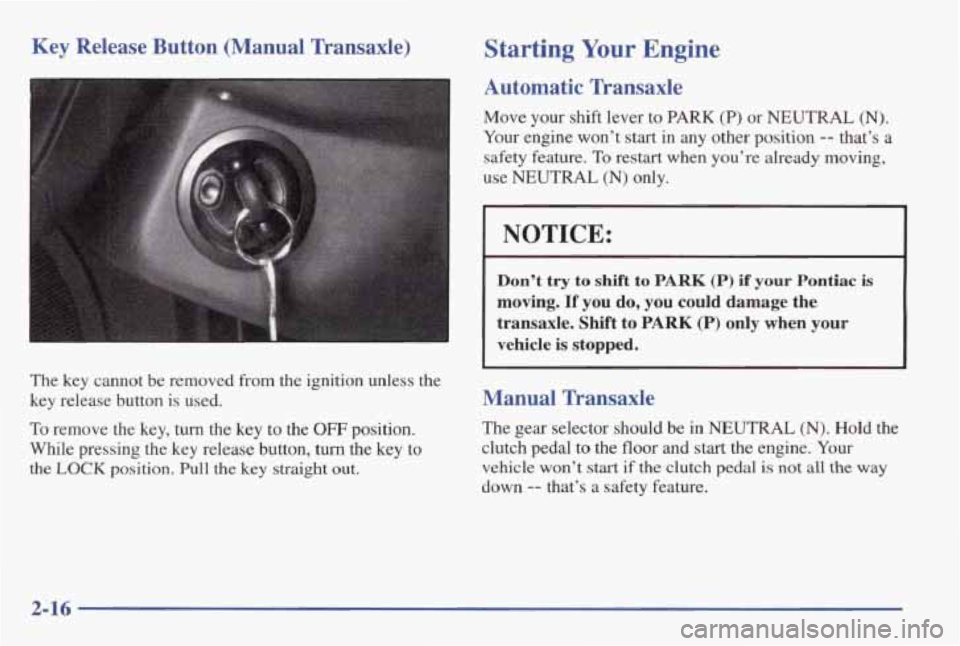
Key Release Button (Manual Transaxle)
The key cannot be removed from the ignition unless the
key release button is used.
To remove the key, turn the key to the OFF position.
While pressing the
key release button, turn the key to
the LOCK position. Pull the key straight out.
Starting Your Engine
Automatic Transaxle
Move your shift lever to PARK (P) or NEUTRAL (N).
Your engine won’t start in any other position -- that’s a
safety feature.
To restart when you’re already moving,
use
NEUTRAL (N) only.
I NOTICE:
Don’t try to shift to PARK (P) if your Pontiac is
moving. If you do, you could damage the
transaxle.
Shift to PARK (P) only when your
vehicle is stopped.
Manual Transaxle
The gear selector should be in NEUTRAL (N). Hold the
clutch pedal to
the floor and start the engine. Your
vehicle won’t
start if the clutch pedal is not all the way
down
-- that’s a safety feature.
2-16
Page 82 of 370
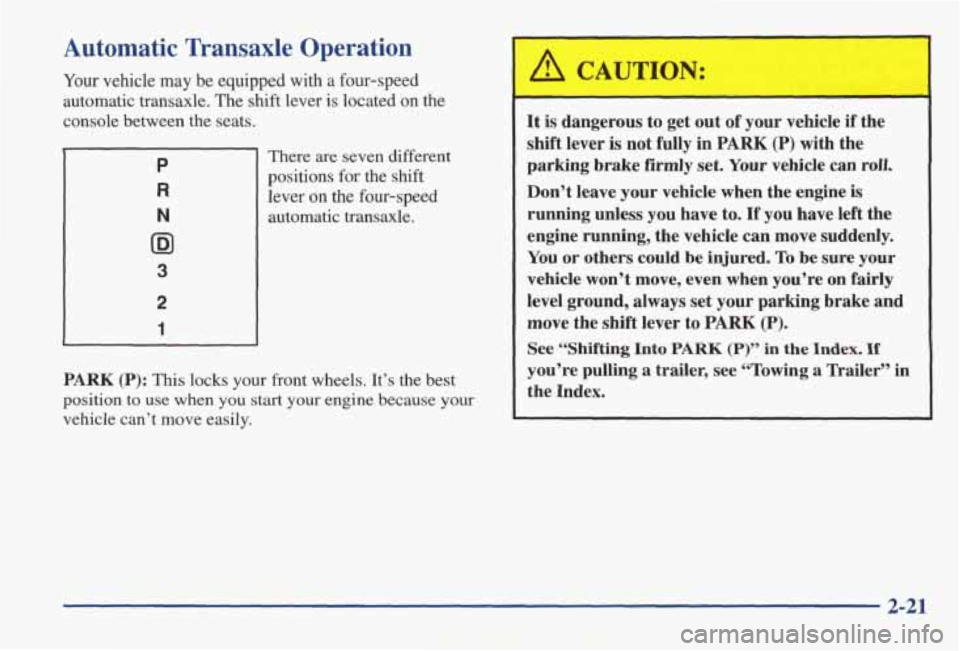
Automatic Transaxle Operation
Your vehicle may be equipped with a four-speed
automatic transaxle. The
shift lever is located on the
console between the seats.
There are seven different
positions for the shift
lever
on the four-speed
N
@I
3
2
1
automatic transaxle.
PARK (P): This locks your front wheels. It’s the best
position
to use when you start your engine because your
vehicle can’t move easily.
A CAUTION:
It is dangerous to get out of your vehicle if the
shift lever is
not fully in PARK (P) with the
parking brake firmly set. Your vehicle can roll.
Don’t leave your vehicle when the engine is
running unless you have to.
If you have left the
engine running, the vehicle can move suddenly.
You or others could be injured. To be sure your
vehicle won’t move, even when you’re on fairly
level ground, always set your parking brake and
move the shift lever to PARK (P).
See “Shifting Into PARK (P)” in the Index. If
you’re pulling a trailer, see “Towing a Trailer’’ i~
the Index.
2-21
Page 83 of 370
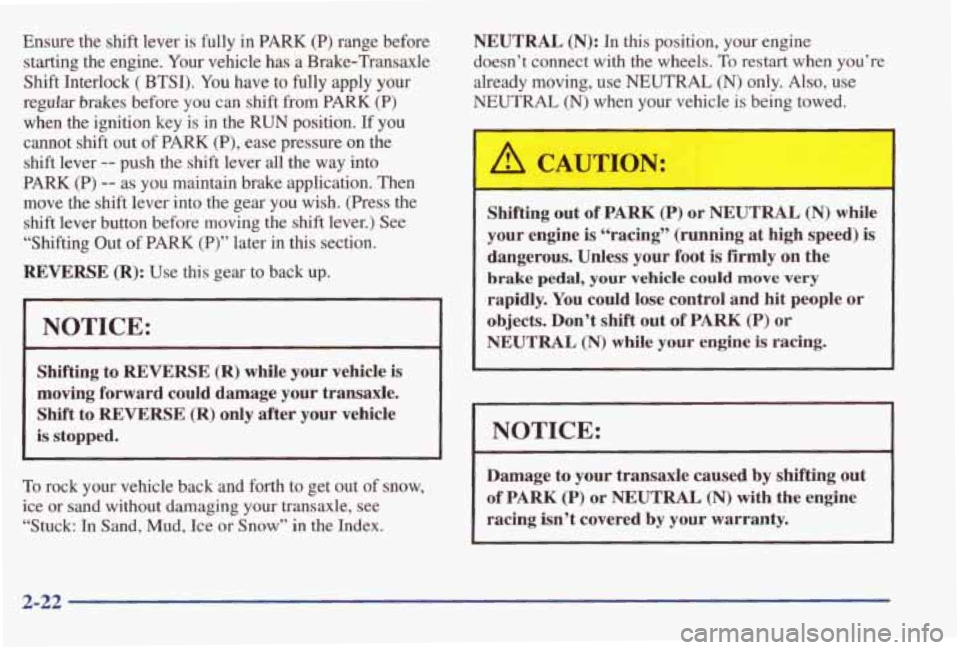
Ensure the shift lever is fully in PARK (P) range before
starting the engine. Your vehicle has a Brake-Transaxle
Shift Interlock
( BTSI). You have to fully apply your
regular brakes before you can shift from PARK (P)
when the ignition key is in the RUN position. If you
cannot
shift out of PARK (P), ease pressure on the
shift lever
-- push the shift lever all the way into
PARK (P) -- as you maintain brake application. Then
move the shift lever into the gear you wish. (Press the
shift lever button before moving the shift lever.) See
“Shifting Out of
PARK (P)” later in this section.
REVERSE (R): Use this gear to back up.
I 1
NOTICE:
Shifting to REVERSE (R) while your vehicle is
moving forward could damage
your transaxle.
Shift to REVERSE (R) only after your vehicle
is stopped.
To rock your vehicle back and forth to get out of snow,
ice or sand without damaging your transaxle, see
“Stuck: In Sand, Mud, Ice
or Snow” in the Index.
NEUTRAL (N): In this position, your engine
doesn’t connect with the wheels.
To restart when you’re
already moving, use
NEUTRAL (N) only. Also, use
NEUTRAL (N) when your vehicle is being towed.
I
Shifting out of PARK (P) or NEUTRAL (N) while
your engine is “racing” (running at high speed) is
dangerous. Unless your foot is firmly on the
brake pedal, your vehicle could move very
rapidly. You could lose control and hit people or
objects. Don’t shift out of PARK (P) or
NEUTRAL (N) while your engine is racing.
NOTICE:
Damage to your transaxle caused by shifting out
of PARK (P) or NEUTRAL (N) with the engine
racing isn’t covered
by your warranty.
2-22 -~
Page 89 of 370
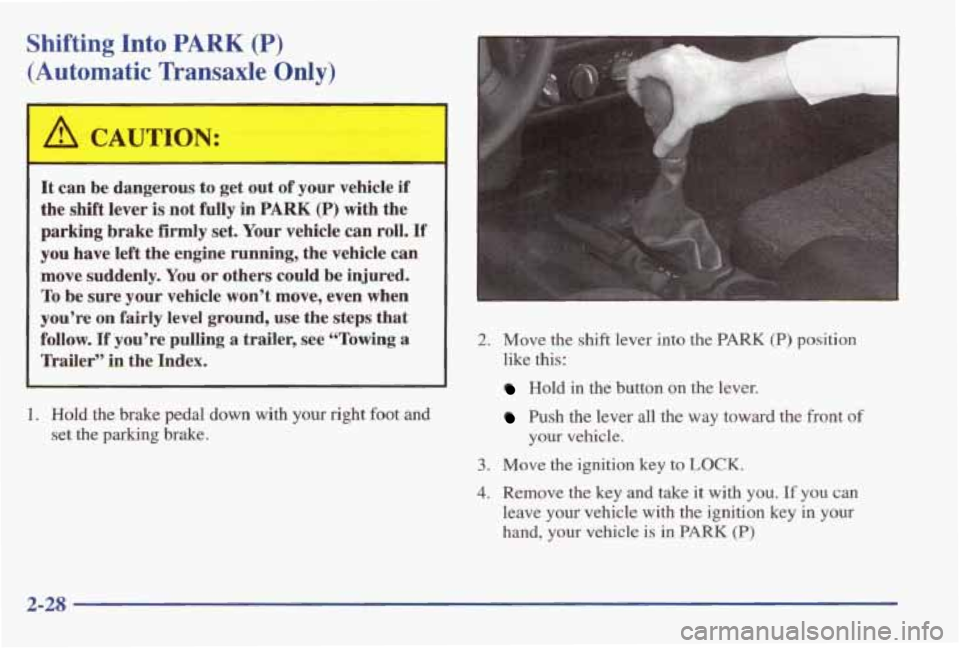
Shifting Into PARK (P)
(Automatic Transaxle Only)
A CAUTION:
It can be dangerous to get out of your vehicle if
the shift lever is not fully in PARK (P) with the
parking brake firmly set. Your vehicle can
roll. If
you have left the engine running, the vehicle can
move suddenly. You or others could
be injured.
To be sure your vehicle won't move, even when
you're on
fairly level ground, use the steps that
follow.
If you're pulling a trailer, see "Towing a
Tkailer" in the Index.
i
1. Hold the brake pedal down with your right foot and
set the parking brake.
2. Move the shift lever into the PARK (P) position
like this:
Hold in the button on the lever.
Push the lever all the way toward the front of
your
vehicle.
3. Move the ignition key to LOCK.
4. Remove the key and take it with you. If you can
leave your vehicle with the ignition key in your
hand, your vehicle is in
PARK (P)
2-28
Page 90 of 370
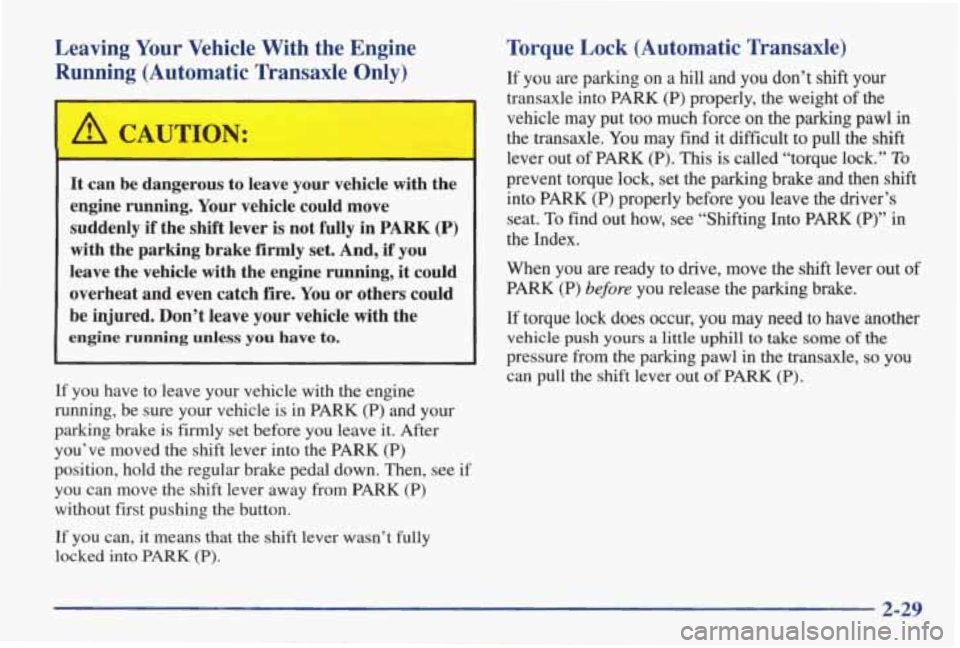
Leaving Your Vehicle With the Engine Running (Automatic Transaxle Only)
A CAUTION:
It can be dangerous to leave your vehicle with the
engine
running. Your vehicle could move
suddenly if the shift lever is not fully in
PARK (P)
with the parking brake firmly set. And, if you
leave the vehicle with the engine running, it could
overheat and even catch fire. You
or others could
be injured. Don’t leave your vehicle with the
engine running unless you have to.
If you have to leave your vehicle with the engine
running, be sure your vehicle is
in PARK (P) and your
parking brake is firmly
set before you leave it. After
you’ve moved the shift lever into the
PARK (P)
position, hold the regular brake pedal down. Then, see
if
you can move the shift lever away from PARK (P)
without first pushing the button.
If you can, it means that the shift lever wasn’t fully
locked into PARK (P).
Torque Lock (Automatic Transaxle)
If you are parking on a hill and you don’t shift your
transaxle into PARK (P) properly, the weight of the
vehicle may put too much force on the parking pawl
in
the transaxle. You may find it difficult to pull the shift
lever out of PARK (P). This is called “torque lock.” To
prevent torque lock, set the parking brake and then shift
into
PARK (P) properly before you leave the driver’s
seat.
To find out how, see ‘‘Shifting Into PARK (P)” in
the Index.
When you are ready to drive, move the shift lever out
of
PARK (P) before you release the parking brake.
If torque lock does occur, you may need to have another
vehicle push yours a little uphill to take some of the
pressure from the parking pawl in the transaxle, so you
can pull the shift lever out of
PARK (P).
2-29
Page 91 of 370
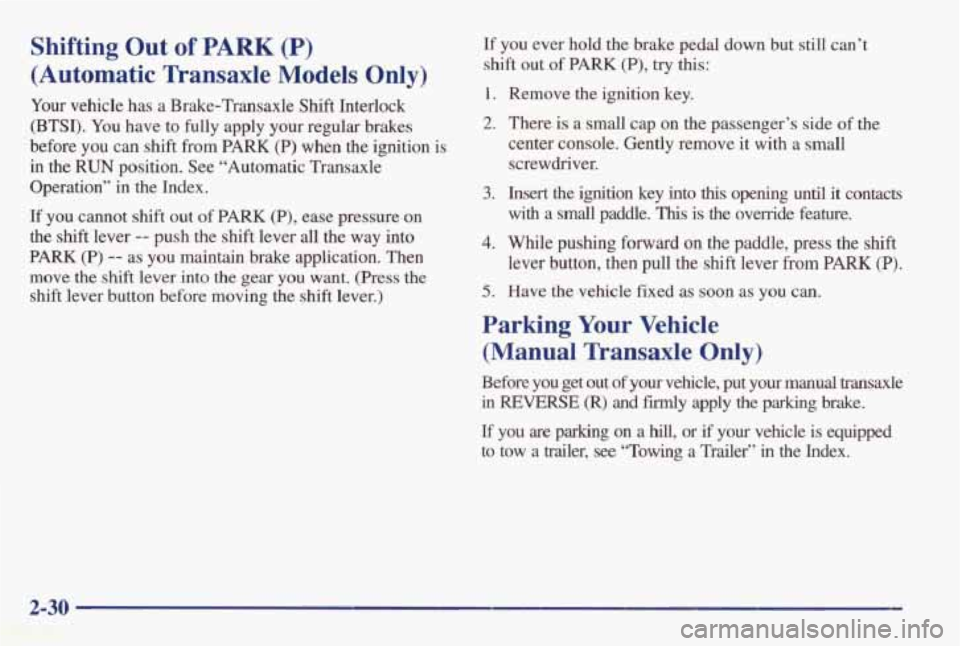
Shifting Out of PARK (P)
(Automatic Transaxle Models Only)
Your vehicle has a Brake-Transaxle Shift Interlock
(BTSI). You have to
fully apply your regular brakes
before you can shift from PARK
(P) when the ignition is
in the
RUN position. See “Automatic Transaxle
Operation” in the Index.
If you cannot shift out of PARK (P), ease pressure on
the
shift lever -- push the shift lever all the way into
PARK (P) -- as you maintain brake application. Then
move the shift lever into the gear you want. (Press the
shift lever button before moving the shift lever.) If you
ever hold the brake pedal down
but still can’t
shift out of
PARK (P), try this:
1. Remove the ignition key.
2. There is a small cap on the passenger’s side of the
center console. Gently remove it
with a small
screwdriver.
3. Insert the ignition key into this opening until it contacts
with a small paddle. This is the override feature.
4. While pushing forward on the paddle, press the shift
lever button, then pull the shift lever from PARK (P).
5. Have the vehicle fixed as soon as you can.
Parking Your Vehicle
(Manual Transaxle Only)
Before you get out of your vehicle, put your manual transaxle
in REVERSE (R) and firmly apply the parking brake.
If you are parking on a hill, or if your vehicle is equipped
to tow a trailer, see “Towing a Trailer’’ in the Index.
2-30
Page 94 of 370
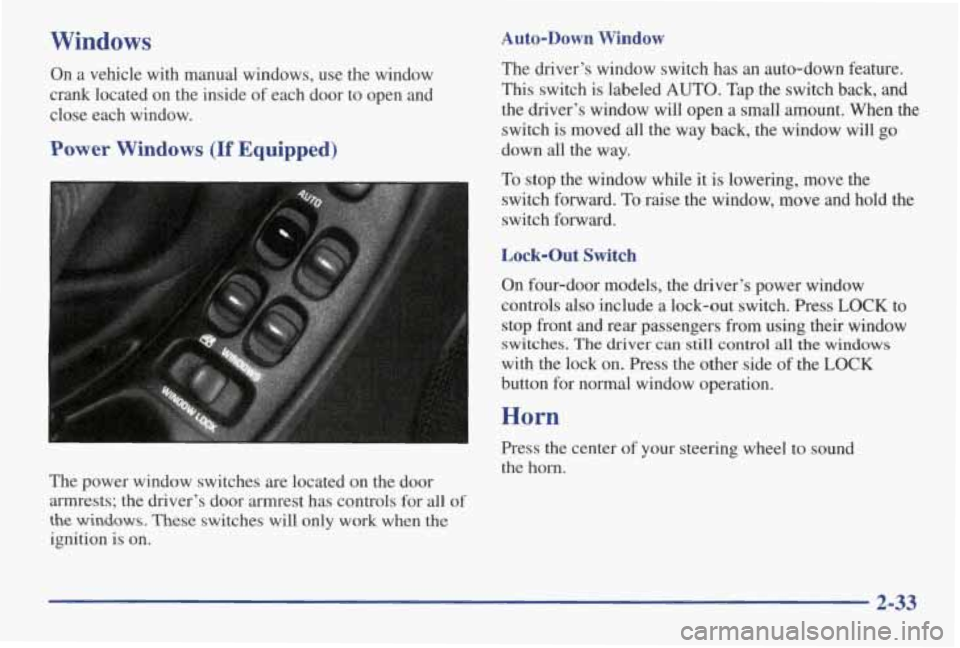
Windows
On a vehicle with manual windows, use the window
crank located on the inside of each door to open and
close each window.
Power Windows (If Equipped)
The power window switches are located on the door armrests; the driver’s door armrest has controls for all
of
the windows, These switches will only work when the
ignition is on.
Auto-Down Window
The driver’s window switch has an auto-down feature.
This switch is labeled
AUTO. Tap the switch back, and
the driver’s window will open a small amount. When the
switch is moved all the way back, the window will go
down all the way.
To stop the window while it is lowering, move the
switch forward.
To raise the window, move and hold the
switch forward.
On four-door models, the driver’s power window
controls
also include a lock-out switch. Press LOCK to
stop front
and rear passengers from using their window
switches.
The driver can still control all the windows
with the lock on. Press the other side of the LOCK
button for normal window operation.
Horn
Press the center of your steering wheel to sound
the
horn.
2-33
Page 95 of 370
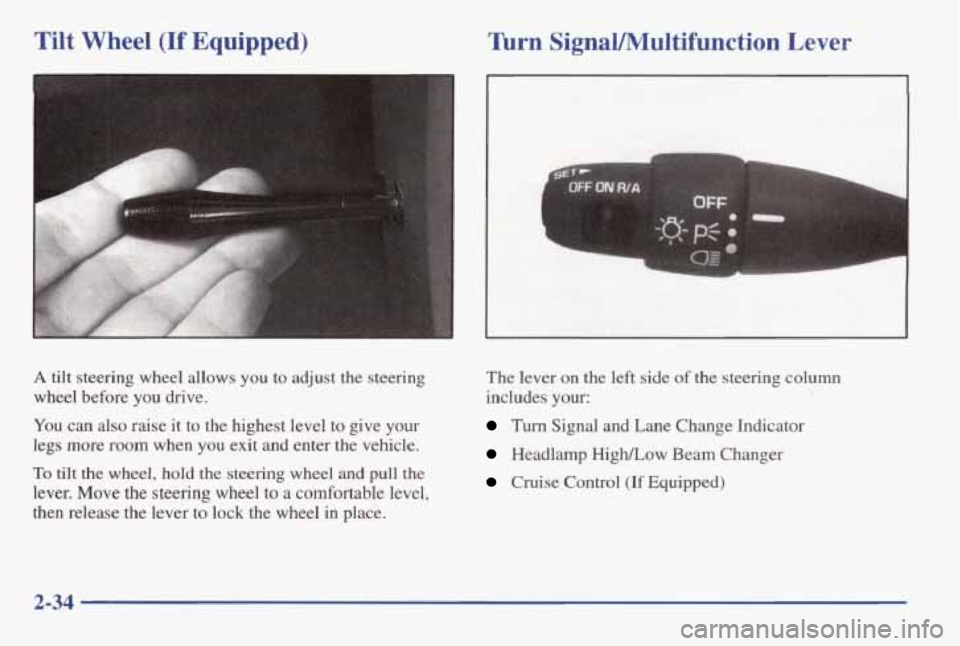
Tilt Wheel (If Equipped) lhrn SignaVMultifunction Lever
A tilt steering wheel allows you to adjust the steering
wheel before you drive.
You can also raise it to the highest level to give your
legs
more room when you exit and enter the vehicle.
To tilt the wheel, hold the steering wheel and pull the
lever. Move the steering wheel to
a comfortable level,
then release the lever
to lock the wheel in place. The lever
on the
left side of the steering column
includes your:
Turn Signal and Lane Change Indicator
Headlamp High/Low Beam Changer
Cruise Control (If Equipped)
2-34
Page 98 of 370
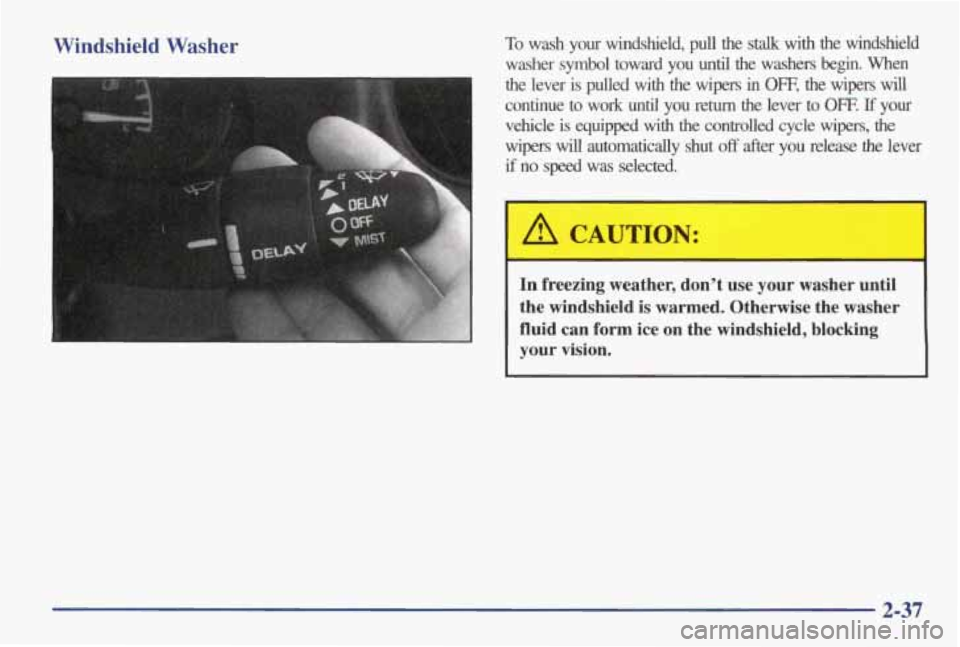
Windshield Washer To wash your windshield, pull the stalk with the windshield
washer symbol toward you until the washers
begin. When
the lever is pulled with the wipers in Om, the wipers will
continue to work until you return the lever to OFF. If your
vehicle
is equipped with the controlled cycle wipers, the
wipers will automatically shut off after you release the lever
if no speed was selected.
A CAUTION:
I
In freezing weather, don’t use your washer until
the windshield is warmed. Otherwise the washer
fluid can form ice on the windshield, blocking
your vision.
2-37